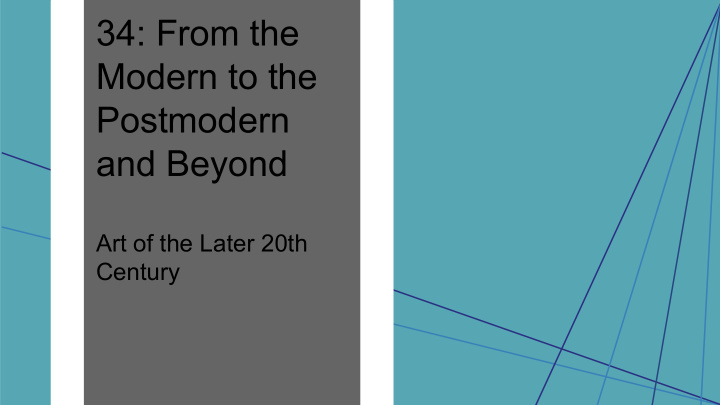



34: From the Modern to the Postmodern and Beyond Art of the Later 20th Century
Painting , Francis Bacon, 1946 The end of World War II left people in a state of despair and The umbrella recalls Neville skepticism. Chamberlain This was painted 1946, a year after World War II The central figure may be a ended. depiction of Joseph Goebbels, Heinrich With the split carcass in the Himmler, Benito Mussolini, background and the red color or Franklin Roosevelt. staining the lips of the central figure, this painting reflects on the butchery of the war. Bacon described his art as “an attempt to remake the violence of reality itself”
Number 1, 1950 (Lavender Mist) , Jackson Pollock, 1950 Abstract Expressionism was a movement which aimed to express the artist's unconscious mind. Part of this movement was Gestural Abstraction which featured spontaneously and energetically applied paint. Jackson Pollock was a great Gestural Abstraction artist. To create this piece and many others, he dripped and splattered paint all over a canvas laying on the floor. His unconventional ways of creating art put the emphasis on how the art was made rather than the finished piece. “I feel nearer, more a part of the painting, since this way I can walk around it, work from the four sides, and literally be in the painting.” -Pollock
Red Blue Green , Ellsworth Kelly, 1963 Die , Tony Smith, 1962 Both of these works show “purity”. Greenberg, an influential art critic, stated, To Greenberg, both of these works would be “pure”. The “the arts are to achieve concreteness, painting embraces the two-dimensional quality of paint as “purity,” by dealing solely with their there is no illusion of depth and the sculpture embraces respective selves - that is, by becoming its three-dimensional quality by being a simple, geometric “abstract” or nonfigurative.” form.
One and Three Chairs , Joseph Kosuth, 1965 This is an example of Conceptual art - art that emphasized an idea rather than how it was expressed. This display consists of a chair, a photograph of a chair, and the definition of a chair. Kosuth “asked the viewer to ponder the notion of what constitutes “chairness”.”
Green Coca-Cola Bottles , Andy Warhol, 1962 This is an example of Pop art. Pop art made use of many Andy Warhol was an American Pop artistic devices that had been artist. He made this piece which ignored by those trying to features repeating images of Coca achieve “purity” in their art. Cola bottles. These devices included signs, symbols, metaphors, allusions, The repetition emphasizes how illusions, and figurative huge this product was in the imagery. By using such culture. devices and familiar images from the media and consumer culture rather than abstraction, Pop art could be understood and appreciated by more people. Warhol used silk-screen printing so that he could mass produce his art.
Seagram Building, New York, Ludwig The Portland Building, Portland, Oregon, Michael Graves Mies Van Der Rohe and Philip Johnson Modern Postmodern This corporate skyscraper is Contrasting the skyscraper on the left, this building is made mostly of glass and is far from simple and sleek. Its’ exterior is elaborately incredibly simple - two decorated with colored paint, ornaments, and vertical characteristics common in shafts. These characteristics makes it Postmodern. Modern architecture.
A Short History of Modernist Painting , Mark Tansey, 1982 Postmodern art frequently commented 1) The image on the left references how art was viewed on things like the politics and past art. during the Renaissance - as if it was through a window. 2) The image in the middle references the modernist ideal - This sequence by Mark Tansey reviews that the piece of art is an object in and of itself. three ways art was approached in 3) The image on the right references how postmodern art history. reflects an artist's self consciousness and the artist’s place in the history of art.
Recommend
More recommend